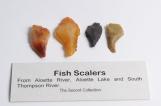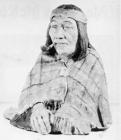1
Aboriginals in the area1910s
Tete Jaune Cache, British Columbia, Canada
 Credits:
Credits:Curtis Culp / Cole Collection
Valley Museum and Achives (McBride)
2
The semi-nomadic Simpcw people were a small group of the Shushwap ("scattered people"), who ranged over 56,000 square miles of the Interior. They lived in summer encampments and in winter pit houses. Using age-old trails and campsites, they wandered to familiar locations where food was available.3
Hudson's Bay trading beads1819-1828
Tete Jaune Cache, British Columbia, Canada
 Credits:
Credits:Secord Collection
4
The first newcomers to this area were fur traders, but not many used the Yellowhead Pass. The two trading companies hired natives as trappers and guides. Pierre Bostonais was one such fur trader. An Iroquois Métis, he came across the Rocky Mountains in 1819 while working for the Hudson's Bay Company.Because of his fair hair, Pierre gained the nickname 'Tete Jaune' - Yellowhead in French. He had a fur stash at Grand Fork, where the Robson and Fraser Rivers meet, that came to be known as Tete Jaune's Cache. Nobody today knows where its precise location is.
Tete Jaune travelled in this area, guiding and hunting, until his death in 1828. The story goes that Pierre was known for his arrogance towards local natives and local bands despised him. The Beaver Indians killed Pierre and his family for invading their land.
6
Evidence of Native habitation still exists at Tete Jaune Cache. Seven pits in the ground are still obvious; these holes were either used to keep food in or as the bottom of pit houses. There are remains of the village campsite and burial grounds also, but much has been destroyed by highway construction.The picture depicts fish net weights used by natives in the Tete Jaune area.
7
DrillsAloette River, Aloette Lake and South Thompson River, British Columbia, Canada
 Credits:
Credits:Secord Collection





